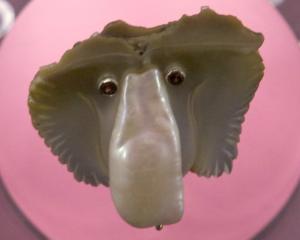Ever heard of how tossing an eyelash off the back of a hand over a shoulder brings you luck?
Artist Zina Swanson had not until she started investigating lucky rituals for her latest work on show in the Dunedin Public Art Gallery (DPAG) BNZ Gallery.
The Christchurch artist came to Dunedin as the Frances Hodgkins Fellow in 2013 from Auckland, where she and her partner escaped to after the earthquakes, and has not left.
''I really like it here. It is a great place.''
Her latest work developed after she bought a book from an internet shopping site and found, when she opened it, that it was full of four-leaf clovers.
''Since then, I had this idea to do something about luck.''
She was very interested in natural materials and the rituals people associated with them, such as blowing the head of a dandelion or breaking a wishbone.
''Did you know that it was lucky to put an acorn in your top pocket, or that if an eyelash falls out, putting it on the back of your hand and throwing it over your shoulder brings you luck?''
After reading about the eyelash lucky trick, she started collecting her eyelashes when they fell out and has put them in her show, attached to a drawing of the back of her hand.
''It is not as extreme as it might look.''
For this exhibition she combined her interpretation of lucky rituals with her interest in bathroom decor, tiling two walls to provide a backdrop to her sculptures and drawings.
''I've worked with tiles once before but I laid them down on the floor. I'd never grouted.''
This time, she and three others placed and grouted about 1000 white tiles on two walls of the gallery to create a clean, white bathroom-like space.
''I'd never tiled before so it was great to have the opportunity to do it properly.''
It was not as easy as it looked, as the tiles were not quite the same size, requiring a bit of rejigging to get them even.
''We had to do them in 1m squares in the end.''
The aim was to direct viewers' attention away from the distracting elements in the room, such as the lift, by redirecting it to the opposite corner.
''It draws you in.''
She was grateful for the help from DPAG staff, as it would have been ''quite horrible'' to do the job all by herself, she said. As it was, it took them four days.
It was not the first time Ms Swanson had used natural materials in her work. She once made a pressed daisy chain that spanned the perimeter of a gallery and in another she collected hundreds of stinging nettles.
''For my Frances Hodgkins work, I made 11,000 hand-rolled terracotta beads.''
It was the ''interesting little things'' that started Ms Swanson collecting things.
''I've always been into it.''
Along with the natural materials, Ms Swanson often added paintings or drawings to her work. In this case, a series of watercolours of a wishbone, a four-leaf clover, thistle seeds and the hand were included.
The use of plants started from a project at Ilam art school in which she covered a chair in rose thorns.
''It was a terrible work. But that method of collecting things has continued on now.''
For the thistle seeds in her work, she let the thistle outside her house grow to about 2m tall to get the seeds.
The objects selected for her creations all had a story behind them, she said.
''It's about the careful selection and placement of objects and the history surrounding them.''
She was pleased at how the work had turned out, although she admitted that after drawing and thinking about it for so long, she tended to get to a point where she did not see it.
''I need to get a bit of distance to appreciate it.''
Because she had used lucky bamboo - there is a feng shui belief that it attracts positive energy - she would need to return to the gallery regularly to water it.
She admitted that including live plants in her work could be a way of staying connected to it.












